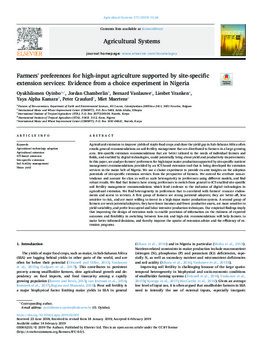Farmers’ preferences for high-input agriculture supported by site-specific extension services: evidence from a choice experiment in Nigeria
Abstract
Agricultural extension to improve yields of staple food crops and close the yield gap in Sub-Saharan Africa often entails general recommendations on soil fertility management that are distributed to farmers in a large growing area. Site-specific extension recommendations that are better tailored to the needs of individual farmers and fields, and enabled by digital technologies, could potentially bring about yield and productivity improvements. In this paper, we analyze farmers' preferences for high-input maize production supported by site-specific nutrient management recommendations provided by an ICT-based extension tool that is being developed for extension services in the maize belt of Nigeria. We use a choice experiment to provide ex-ante insights on the adoption potentials of site-specific extension services from the perspective of farmers. We control for attribute non-attendance and account for class as well as scale heterogeneity in preferences using different models, and find robust results. We find that farmers have strong preferences to switch from general to ICT-enabled site-specific soil fertility management recommendations which lend credence to the inclusion of digital technologies in agricultural extension. We find heterogeneity in preferences that is correlated with farmers' resource endowments and access to services. A first group of farmers are strong potential adopters; they are better-off, less sensitive to risk, and are more willing to invest in a high-input maize production system. A second group of farmers are weak potential adopters; they have lower incomes and fewer productive assets, are more sensitive to yield variability, and prefer less capital and labor intensive production techniques. Our empirical findings imply that improving the design of extension tools to enable provision of information on the riskiness of expected outcomes and flexibility in switching between low-risk and high-risk recommendations will help farmers to make better informed decisions, and thereby improve the uptake of extension advice and the efficiency of extension programs

